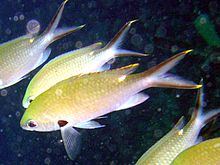
Aulostomus maculatus, the trumpetfish which is also known as the West Atlantic trumpetfish, is a long-bodied fish with an upturned mouth; it often swims vertically while trying to blend with vertical coral, such as sea rods, sea pens, and pipe sponges.
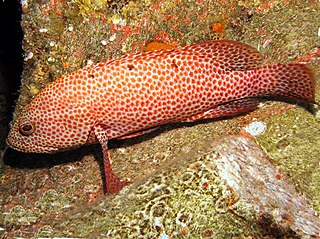
The graysby is a species of marine ray-finned fish, a grouper from the subfamily Epinephelinae which is in the family Serranidae which also includes the anthias and sea basses. It is found in the western Atlantic. It is associated with reefs and is a quarry species for commercial and recreational fisheries.

The New Zealand demoiselle, Chromis dispilus, is a damselfish of the genus Chromis, found between North Cape and East Cape of the North Island of New Zealand to depths of about 60 metres, off rocky coasts. Its length is between 15 and 20 cm. Males are highly territorial as they defend their nesting area from other males and other species. These aggressive fish defend their eggs laid by their female counterpart. Spawning occurs between the months of December and March. The New Zealand demoiselle's territory and nesting grounds of this fish are usually the largest in a medium population density. Like most territorial fish they tend to spawn more in higher densities of the same species compared to lower densities. Aggression levels tend to be higher amount higher densities of the same species and lower levels in smaller densities. Aggression also tends to be higher during spawning then during egg defending. Elevated plasma levels of androgen testosterone and 11-Ketotesterone are associated with the heighten levels of aggression shown by the males.
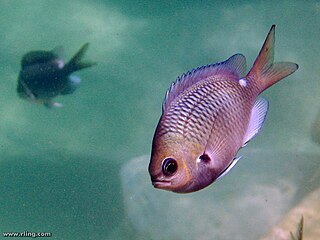
The one-spot puller or brown puller, Chromis hypsilepis, is a damselfish of the genus Chromis, found off south-east Australia and between North Cape and East Cape of the North Island of New Zealand to depths of about 60 metres, off rocky coasts. It grows to a length between 15 and 20 centimetres.
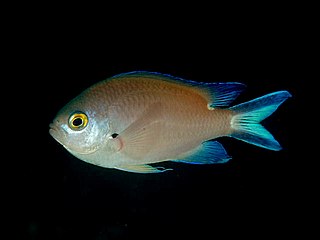
The smokey chromis, also known as the smokey puller or the yellow demoiselle, is a damselfish of the genus Chromis, found in the tropical waters of the eastern Indian Ocean, and the western Pacific Ocean across to north New Zealand, at depths of between 3 and 25 metres, off rocky or coral reef areas. Its length is between 5 and 10 cm.

Hypoplectrus gemma, the blue hamlet, is a species of marine ray-finned fish, a sea bass from the subfamily Serraninae which is part of the family Serranidae, which also includes the groupers and anthias. It is found in the western Atlantic Ocean and occasionally makes its way into the aquarium trade.
Chromis sanctaehelenae is a species of fish, in the family Pomacentridae.

Chromis cyanea is a damselfish in the subfamily Pomacentrinae, found in Bermuda, southern Florida and the Caribbean Sea.

Chromis chromis, the damselfish or Mediterranean chromis is a small species of ray-finned fish of the family Pomacentridae from the Eastern Atlantic and Mediterranean.
Chromis limbaughi is a Chromis from the Eastern Central Pacific. It occasionally makes its way into the aquarium trade. It grows to a size of 10 cm in length. The specific name honours the zoologist and diver Conrad Limbaugh (1925-1960) who collected some specimens and was the first to photograph this species.

Hypoplectrus indigo, the indigo hamlet, is a species of marine ray-finned fish, a sea bass from the subfamily Serraninae which is part of the family Serranidae, which also includes the groupers and anthias. It is found in the central western Atlantic Ocean. It occasionally makes its way into the aquarium trade.
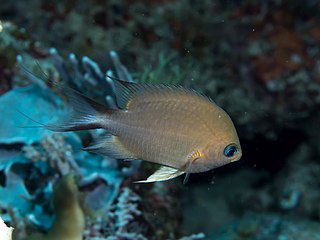
Chromis amboinensis is a damselfish from the Western Pacific. It occasionally makes its way into the aquarium trade. It grows to a size of 9 cm (3.5 in) in length.
The yellowmouth grouper, also known as the crossband rockfish, grey mannock, hamlet, harlequin rockfish, princess rockfish, rockfish, salmon grouper, salmon rock fish or scamp, is a species of marine ray-finned fish, a grouper from the subfamily Epinephelinae which is part of the family Serranidae, which also includes the anthias and sea basses. It is found in the Caribbean and in the tropical waters of the Atlantic Ocean. It is also found in pockets in Brazil. It is a fairly large fish and it gets its name from the yellow around its mouth.

The yellow chromis or yellow puller is a species of marine fish in the family Pomacentridae. It is widespread throughout the tropical waters of the central Indo-Pacific region. A small fish, it can reach a maximum size of 17 cm in length.

The purple reeffish is a species of fish in the family Pomacentridae. It occurs from southern Florida through the Caribbean Sea to northern Brazil. The specific name honours William Beverly Scott (1917-2014) who was the Curator of Ichthyology and Herpetology ate the Royal Ontario Museum in Toronto.
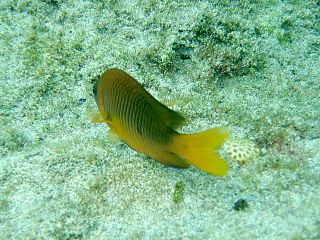
Chromis insolata is a species of fish in the family Pomacentridae. It is commonly known as the sunshinefish, and found in the Western Atlantic. It occasionally makes its way into the aquarium trade. It grows to a size of 16 cm in length.

The yellowtail reeffish is a species of damselfish in the family Pomacentridae.
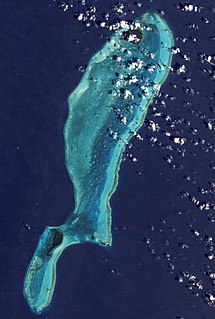
Lighthouse Reef is an atoll in the Caribbean Sea, the easternmost part of the Belize Barrier Reef and one of its three atolls, the other two being Turneffe Atoll and Glover's Reef. Lighthouse Reef is located about 80 kilometres (50 mi) southeast of Belize City. The atoll is of oblong shape, approximately 35 kilometres (22 mi) long from north to south, and about 8 kilometres (5.0 mi) wide. It forms a shallow sandy lagoon with an area of 120 square kilometres (46 sq mi) and a depth between 2 to 6 metres deep.
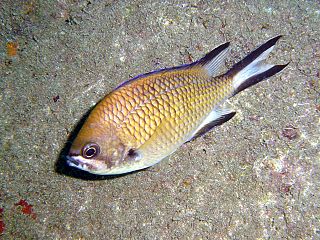
The Azores chromis or Atlantic chromis is a species of damselfish from the family Pomacentridae which is found in the Macaronesian Islands of the temperate eastern Atlantic Ocean and has been reported from coastal regions of western Africa.
Chromis lubbocki is a species of marine fish of the family Pomacentridae. This fish grows to 12.5 cm maximal length. It occurs in the eastern Atlantic Ocean, off the coast of Cape Verde. The specific name honours the marine biologist Hugh Roger Lubbock (1951-1981) who led the Cambridge Expedition to Saint Paul's Rocks, part of the Cape Verde Islands, who collected the type specimen and realised it was a new species.
